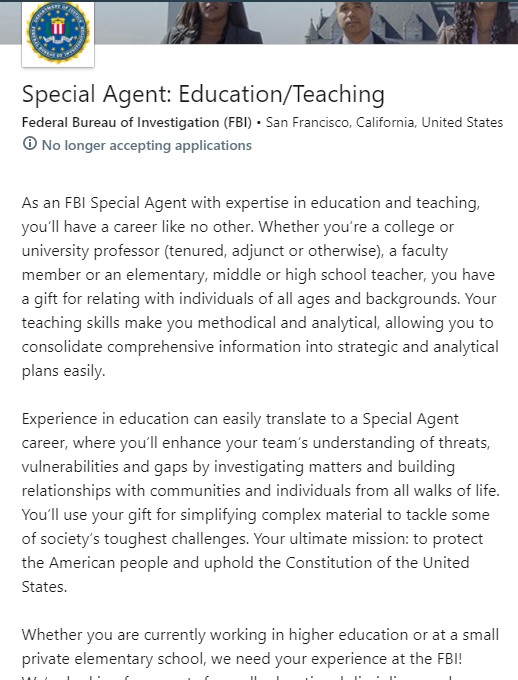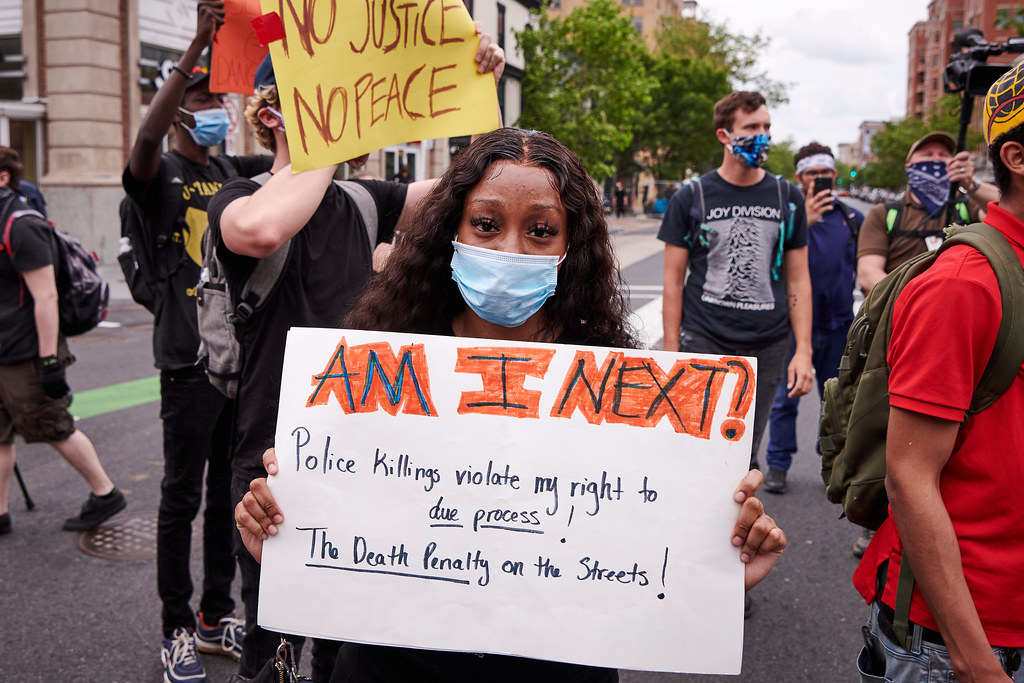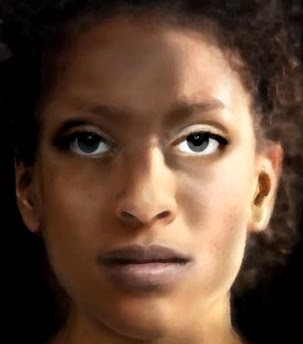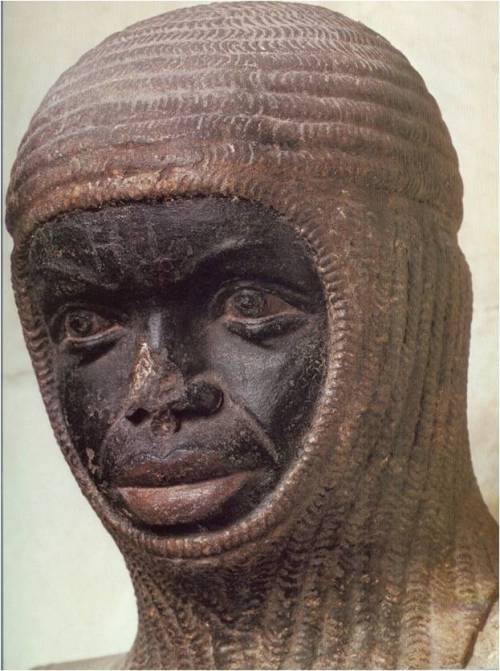I’ve been job hunting for months. As someone with many years of teaching experience under my belt, I have alerts set for education-related positions on several job sites. The entire time I’ve been searching, I’ve been seeing job postings from the FBI looking for “experienced teachers.” Here’s a screenshot of an ad I found on LinkedIn in June. It says they’re “no longer accepting applications,” but this same ad has been reposted many times targeting cities all over the US.

Here are a few screenshots from LinkedIn that show some of the breadth of the FBI recruitment of teachers:



There are many more. The job posts labeled “Special Agent” list “EDUCATION/TEACHING” as a special skill for which they’re specifically recruiting.
Back in June, I posted to my personal social media accounts about this, speculating that the FBI was planning to put undercover operatives in American classrooms to spy on educators who were teaching things the GOP calls “liberal indoctrination,” such as climate science, ethnic studies, critical race theory, race-based demographics, and history that centers the experience of BIPOC (such as the 1619 Project or discussions of the genocide of Native peoples). In June, this was just speculation.
Well, the other shoe has dropped. Now we have this:

Trump and Russ Vought, the Director of the Office of Management and Budget, are, astonishingly, urging Americans to report other Americans for “un-American” activity. Once again, the US Government is demanding that Americans “name names” in order to ruin the careers and lives of fellow Americans. Joseph McCarthy lives.
A lot of people confuse McCarthy with the House Un-American Activities Committee of a few years prior. While McCarthy didn’t run the HUAC, its focus on rooting out “Communist infiltration” and its abusive tactics are all part of what we now call “the McCarthy era.” McCarthy campaigned for his Senate seat on paranoid delusions of a Deep State, supposedly made up of Communists who had “infiltrated” the government and were attempting to destroy it from within. Sound familiar?
Once in the Senate, Joseph McCarthy became more insistent that “Communists” had “infiltrated” the US government. He forced hundreds of loyal Americans into hearings that were notoriously insulting and hostile. All the Democrats on his committee resigned, and, eventually, bit by bit, McCarthy lost Republican support as well, leaving the hearings in the hands of himself and his attack dog, Roy Cohn.
In 1954, they decided to take on the US Army, accusing it of being controlled by their imaginary Communist Deep State. The Army-McCarthy hearings ended, along with McCarthy’s public support and career, with Army attorney Joseph Welch’s immortal words, “Have you no sense of decency?” McCarthy died just three years later, but Roy Cohn returned to New York, where he eventually took on a protegé– Donald Trump.

Trump, then in his 30s, was (for once in his life) a good student. Now, 40 years later, Trump has used what he learned from Cohn and taken the tactics of McCarthy’s Red Scare to create his own Red Hat Scare. The Office of Management and Budget has provided a handy email address to use to turn your neighbors and coworkers in for ”any sightings of critical race theory trainings” because Trump has decided that discussions of racism are “un-American” activities.
How is Trump defining “un-American”? The average American has no idea what “critical race theory” is, so Trump’s relentless lies about it provide the definition. Trump has attacked anything that mentions white privilege or systemic racism, anything supportive of protests for racial justice, and anything that says the words “Black lives matter.” He has, after years of these attacks, variously referred to anything related to the struggle for racial justice as “Antifa,” “the radical left,” and, now, “critical race theory.” He clearly thinks “critical” means “to criticize” rather than “to think critically,” and assumes the fight for racial justice is an attack on white people– specifically, on him.

The Trump Administration has imagined a nefarious purpose for any type of education or training around race, and is instructing its cult followers to “report” any “sighting” of it in “Federal Agencies.” And while it’s comforting to assume Trump means in his own administration only by “Federal Agencies,” remember that he has already said that schools and universities that teach “critical race theory” will be cut off from federal funding, so he has already very much included them in this. They’re clearly seeing public education as a “Federal Agency,” and any kind of education as a potentially “un-American training.” Just yesterday, the Department of Education announced it is “investigating” Princeton University– a private university– just for saying publicly that systemic racism exists. Princeton’s admission that systemic racism exists on campus is being weaponized against them in a clear attempt by the Trump Administration to bully educators and intimidate us from discussing the realities of systemic racism.
And the FBI has been trying to recruit experienced educators for months.
Are there undercover FBI agents currently placed in schools and universities? Is this what Vought means by “working with other agencies”– like the FBI– to “identify un-American trainings”?
In addition to the Princeton announcement yesterday, Trump once again directly targeted schools for “un-American” education, and he announced the formation of a “national commission to promote patriotic education.” How long will it be before he sends DeVos or even Barr to investigate an HBCU? Or the University of Chicago’s Race & Ethnic Studies Department? Or the New York Public School District?
Since nearly anything can be termed “un-American trainings,” this is clearly a weapon used to silence discussions of race in America. Past experience teaches us that any weapon Trump has will be used in service to his personal grievances, and that both William Barr and the Senate GOP will enable every corrupt, horrific abuse he cares to commit.
Whether there are undercover FBI agents placed to surveil schools and universities or not, make no mistake: This is about targeting and silencing BIPOC people, especially Black people, and their allies. Trump isn’t satisfied gassing, shooting, or disappearing protesters for racial justice; he’s not satisfied with the prospect of using a supervillain-style heat ray against them. Now he wants to prevent us from even discussing racism.

Think about this email address and the Trump Administration’s urging that the public “report” any “un-American trainings” to the Office of Management and Budget.
What will the Office of Management and Budget be doing with a report that Ms. Kennedy taught “critical race theory” in her 10th grade English class by having students read a chapter from Ijeoma Oluo’s So You Want to Talk About Race? What will the Office of Management and Budget be doing with a report that Dr. Abiola, Chair of the Department of Chemistry, required his department to do a day-long retreat on anti-racist pedagogy? What will the Office of Management and Budget be doing with the fact that nearly every university in the nation has an ethnic studies department?
And what will the Office of Management and Budget be doing with the information that schools and universities won’t begin pretending that white privilege and systemic racism do not exist just because Trump demands it? Does Trump imagine he can intimidate HBCUs into lying about the lived experience of their faculty and students? Does Trump think we will all just set aside the mountain of data we have on these topics because he said so?
Trump will not win this fight.
More Americans believe racial and ethnic discrimination is a major problem in America than support Donald Trump.
More Americans support Black Lives Matter than support Donald Trump.
Trump is dreaming if he thinks ethnic studies courses can be bullied out of existence. In 2017, Mike Pence’s own home state of Indiana passed a law requiring all Indiana high schools to offer an ethnic studies course at least once a year.
Trump. Will. Not. Win. This. Fight.
Trump does not get to define “un-American.” We will not sit silently by while Trump defines “un-American” as “BIPOC.” We will not sit silently by while Trump demands punishment for BIPOC speaking out about the truth of their lives.
Pull your [ALLEGED, ugh] undercover FBI agents out of our schools and universities, Don.
We will not sit silently by while Trump tries to force this nation into a new era of McCarthyism.
Support Bitter Gertrude by becoming a Patreon patron!











